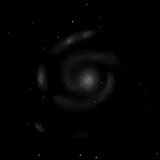
| MESSIER 101 |
|---|
RA: |
14h 03m 12s |
|
DEC: |
+54° 21' 00'' |
|
Type: |
Spiral galaxy |
|
NGC: |
5457 |
|
Magnitude: |
7.60 |
|
Surface brightness : |
14.90 |
|
Apparent dimensions : |
28.5'x28.3' |
|
Distance: |
27,000,000 ly |
|
M101 was discovered by Pierre Méchain on March 27, 1781, and added as one of the last entries in Charles Messier's catalog. It was one of the first "spiral nebula" identified as such, in 1851 by William Parsons, the third Earl of Rosse. Although extended 28 arc minutes on photos and quite bright, only the central region of this galaxy is visible in smaller telescopes, best at low powers. M101 is the brightest of a group of at least 9 galaxies, called the M101 Group. The brightest companions are NGC 5474 (type Sc, 10.85 mag vis) to the SSE and NGC 5585 (Sa, 11.49 mag). The distance of M101 has been determined by the measurement of Cepheid variables with the Hubble Space Telescope in 1994/95 to be about 24 +/- 2 million light years. This is also in good agreement with a distance determined from the Planetary Nebula Luminosity functionwhich is 25.1 +/- 1.6 million light years. According to the recent recalibration of the Cepheid distance scale, the "true" distance of M101 should be closer to a 10 percent higher value (27 million light years). Suggestions of the spiral arms can be glimpsed in telescopes starting from 4 inch as nebulous patches. Several of these patches (i.e., spiral arm fragments) were assigned their own catalog numbers by William Herschel and later observers. Under best conditions available to me, I was able to spot core and few very faint spiral arms through the 8" telescope. |
||
VEDRAN VRHOVAC© 2006.-2007. |
